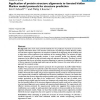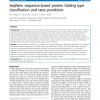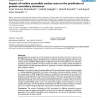82 search results - page 5 / 17 » Feature Selection Methods for Improving Protein Structure Pr... |
BMCBI
2008
13 years 7 months ago
2008
Background: We present a novel method of protein fold decoy discrimination using machine learning, more specifically using neural networks. Here, decoy discrimination is represent...
BMCBI
2006
13 years 7 months ago
2006
Background: One of the most powerful methods for the prediction of protein structure from sequence information alone is the iterative construction of profile-type models. Because ...
BMCBI
2010
13 years 7 months ago
2010
Background: Protein folding rate is an important property of a protein. Predicting protein folding rate is useful for understanding protein folding process and guiding protein des...
BMCBI
2008
13 years 7 months ago
2008
Background: The problem of accurate prediction of protein secondary structure continues to be one of the challenging problems in Bioinformatics. It has been previously suggested t...
BMCBI
2010
13 years 7 months ago
2010
Background: G-protein-coupled receptors (GPCRs) play a key role in diverse physiological processes and are the targets of almost two-thirds of the marketed drugs. The 3 D structur...



